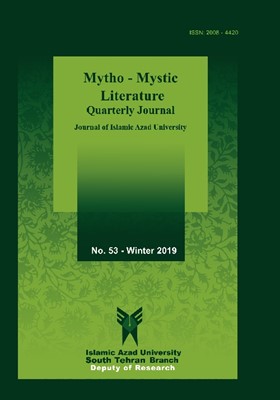Two New Readings of the Mythological Narratives Based on Henri Corbin's Shiite Reading
Subject Areas : Mytho
1 - The Associated Professor of Persian Language and Literature, Azarbaijan University of Shahid Madani
Keywords: Henry Corbin, Iranian and Mazda Myths, Shia Islam, Zoroastrian Religion, Spendārmad (Sepandarmaz), Fatimah,
Abstract :
Henry Corbin (1903 – 1978), prominent French Shia scholar and philosopher, introduces the philosophical and mystical relationship between Hekmat Khosravani (the philosophy of ancient Iran) and Shia Islamic narrations and philosophy of Illustration (Falsafeh Eshraq). By reviewing the works of Suhrawardi and Ibn Sina, Corbin not only recognized the essence of Hekmat Khosravani, but also focused on the main sources of the Khosravan Wisdom, the wisdom of Mazdayasna, the mythological narratives, and the related texts of the Zoroastrian religion; also, he pursued the subject of similarity and adaptation of these doctrines with the traditions of Iranian Islam. In the present article, Corbin's studies are examined that address the symbolic mystical tales or Shia Islamic narrations and their similar correspondences in Hekmat Khosravani or the Mazda religion. In Shi'ite and Iranian ancient thoughts, there are two valuable forgotten subjects that Corbin has discussed them. One of them is the issue of continuity of generation and kingdom of Fereydun and Iraj through the son of his daughter, Manūchehr; the other is the introduction of Spendārmad (Sepandarmaz) as goddess of water and Earth. The former is similar to the continuity of the generation of the Prophet through his daughter, Fatimah; and the latter is similar to “Mehrieh” or Fatimah's dowry.
آموزگار، ژاله. 1376. تاریخ اساطیری ایران. تهران: سمت.
ابنبابویه، محمدبن علی. 1362. الخصال. ج2. قم: جامعه مدرسین.
ــــــــــــــــــــ .1380. عللالشرایع. ترجمة ذهنی تهرانی. ج1. قم: مومنین.
اسماعیلپور، ابوالقاسم. 1387. اسطوره بیان نمادین. تهران: سروش.
اوشیدری، جهانگیر. 1371. دانشنامۀ مزدیسنا. تهران: مرکز.
پاکزاد، فضلالله (مصحح). 1384. بندهشن. ج1. تهران: مرکز دایرةالمعارف بزرگ اسلامی.
پورداوود، ابراهیم.1380. فرهنگ ایران باستان. تهران: اساطیر.
حاکم نیشابوری. محمدبن عبدالله. 1411. المستدرکالصحیحین. تحقیق مصطفی عبدالقادر عطا. ج3، بیروت: دارالکتب العلمیه.
حسنیالبیرجندی. حسین. 1379. غریبالحدیث فی بحارالانوار. ج1. تهران: دارالحدیث.
راشدمحصل، محمدتقی(محقق). 1366. گزیدههای زادسپرم. تهران: وزارت فرهنگ و آموزش عالی.
رضی، هاشم. 1381. آیین مهر. تهران: بهجت.
ژینیو، فیلیپ. 1390. ارداویرافنامه. ترجمة ژاله آموزگار. تهران: معین.
عرب گلپایگانی، عصمت. 1376. اساطیر ایران باستان. تهران: هیرمند.
فرخزاد، پوران. 1386. مهرۀ مهر. تهران: نگاه.
فردوسی، ابوالقاسم. 1386. شاهنامه. جلد1. تصحیح جلال خالقیمطلق. تهران: مرکز دایرةالمعارف بزرگ اسلامی.
ــــــــــــــــ . 1386. نامۀ باستان. ج1. گزارش و ویرایش میرجلالالدین کزّازی. تهران: سمت.
قلیزاده، خسرو. 1387. فرهنگ اساطیر ایرانی. تهران:پارسه.
کربن، هانری. 1374. ارض ملکوت. ترجمة ضیاءالدین دهشیری. تهران: طهوری.
کریستن سن، آرتور. 1390. ایران در زمان ساسانیان. ترجمة رشیدیاسمی. تهران: بهزاد.
گیرشمن، رومن. 1372. ایران از آغاز تا اسلام. ترجمة محمد معین. تهران: علمی و فرهنگی.
مجلسی، محمدباقر. 1403. بحارالانوار. تحقیق السید ابراهیم المیانجی و محمدالباقر البهبودی. ج43 بیروت: دارإحیا التراث العربی.
ـــــــــــــــــ . 1377. زندگانی حضرت زهرا(س). ترجمة محمد روحانی علی آبادی. تهران: مهام.
ورمازرن، مارتین. 1375. آیین میترا. ترجمة بزرگ نادرزاد. تهران: چشمه.
هیلنز، جان راسل. 1385. شناخت اساطیر ایران. ترجمة باجلان فرخی. تهران: اساطیر.
یشتها. 1377. ترجمة ابراهیم پورداود. تهران: اساطیر.
_||_References
Amūzgār, Žāleh. (1997/1376SH). Tārīx-e asātīrī-yr īrān. Tehrān: Samt.
Arab Golpāyegānī. (1998/1376SH). Asātīr-e īrān-e bāstān. Tehrān: Hīrmand.
Bondahešn. With the effort of Fazollāh Pakzād. Vol. 1. Tehrān: Markaz-e Dāyeratol Ma’āref-e Bozorg-e Eslāmī.
Christensen, Arthur. (2012/1390SH). Īrān dar zamān-e sāsāniyān ( L'Iran sous les Sassanides). Tr. by Rašīd Yāsemī. Tehrān: Behzād.
Corbin, Henry. (1996/1374SH). Arz-e malakūt (Terre celeste et corps de resurrection de l'Iran Mazdeen a l'Iran Schiite). Tr. by Ziyā al-dīn Dehšīrī. 2nd ed. Tehrān: Tahūrī.
Ebn-e bābvīye, Mohammad ebn-e Alī. (1983/1362SH). Al-xesāl. Vol. 2. Qom: Jāme’e-ye Modarresīn.
_______________________________. (2001/1380SH). Elal al-šarāye’. Tr. by Mohammad Javād Zehnī Tehrānī. Vol. 1. Qom: Mo`menīn.
Esmā’īlpūr, Abolqāsem. (2008/1387SH). Ostūre bayān-e namādīn. Tehrān: Sorūš.
Farroxzād, Pūrān. (2007/1386SH). Mohre-ye mehr. Tehrān: Negāh.
Ferdowsī, Abolqāsem. (2007/1386SH). Nāme-ye bāstān. Vol. 1. Ed. by Mīr Jalāl al-dīn Kazzāzī. Tehrān: Samt.
________________. (2007/1386SH). Šāh-nāme. Vol. 1. Ed. by Jalāl Xāleqī Motlaq. Tehrān: Markaz-e Dāyeratol Ma’āref-e Bozorg-e Eslāmī.
Ghirshman, Roman. (1994/1372SH). Īrān az āqāz tā eslām (Iran Des origines A L'Islam). Tr. by Mohammad Mo’īn. Tehrān: Elmī va Farhangī.
Gignoux, Philippe. (2012/1390SH). Ardāvīrāf-nāme. Tr. by Žāleh Amūzgār. Tehrān: Mo’īn.
Hākem Neyšābūrī, Mohammad ebn-e Abdollāh. (1411). Al-mostadrak al-sahīhīn. With the effort of Mostafā Abdolqāher. Vol. 3. Beirut: Dār al-kotob al-elmīyat.
Hasanī al-bīrjandī, Hossein. (2000/1379SH). Qarīb al-hadīs fī behār al-anvār. Vol. 1. Tehrān: Dār al-hadīs.
Hinnells, John Russell. (2006/1385SH). Šenāxt-e asātīr-e īrān (Persian Mythology). Tr. by Mohammad Hossein Bājelān Farroxī. Tehrān:Asātīr.
Majlesī, Mohammad Bāqer. (1403). Behār al-anvār. With the effort of Al-seyyed Ebrāhīm Al-miyānjī. & Mohammad Al-bāqer Al-behbūdī. Vol. 43. Beirut: Dār Ehyā Al-toras Al-arabī.
_____________________. (1999/1377SH). Zendegānī-ye hazrat-e zahrā. Tr. by Mohammad Rohānī Alī Ābādī. Tehrān: Mahām.
Pūrdāvūd, Ebrāhīm. (2001/1380SH). Farhang-e īrān-e bāstān. Tehrān: Asātīr.
Qolīzāde, Xosrow. (2008/1387SH). Farhang-e asātīr-e īrānī. Tehrān: Pārse.
Rāšed Mohassel, Mohammad Taqī (Mohaqqeq). (1988/1366SH). Gozīde-hā-ye zādesparm. Tehrān: Vezārat-e Farhang va Āmūzeš-e Ālī.
Razī, Hāšem. (2002/1381SH). Ā’īn-e mehr. Tehrān: Behjat.
Ūšīdarī, Jahāngīr. (1993/1371SH). Dāneš-nāme-ye mazdīsnā. Tehrān: Markaz.
Vermaseren, Maarten Jozef. (1997/1375SH). Ā’Īn-e mītrā (Mithra Ce Dieu mysterieux). Tr. by Bozorg Nāder Zād. Tehrān: Češme.
Pūrdāvūd, Ebrāhīm. (1998/1377SH). Yašt-hā. Tehrān: Asātīr.


